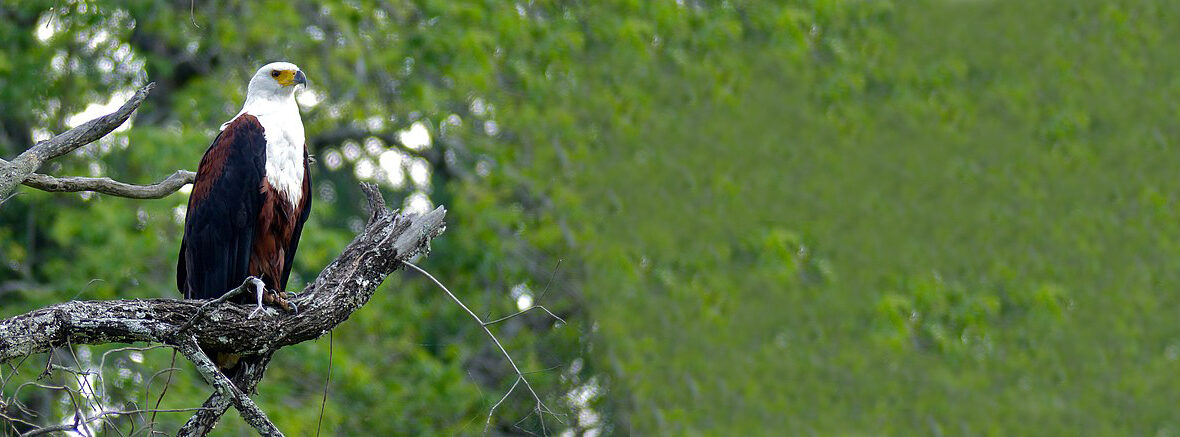
The African fish eagle, aka African sea eagle, can be found throughout most of Africa. They prefer grasslands, swamps, marshes, tropical rainforests, freshwater lakes, reservoirs, fynbos (heathland or shrubland vegetation), desert-bordering coastlines, and rivers. Even though they face the threats of habitat loss and destruction at the hands of residential and commercial developments; overfishing; and pollution, they are abundant and have a stable population. The IUCN lists these eagles as Least Concern.
First the Stats…
Scientific name: Haliaeetus vocifer
Weight: Up to 7.9 lbs.
Length: Up to 2.5 feet
Wingspan: Up to 7.5 feet
Lifespan: Up to 24 years
Now on to the Facts!
1.) A group of eagles is called a aerie or convocation.
2.) Like other eagles, they are diurnal (active during the day).
3.) African fish eagles are monogamous (mate for life).
4.) With the help of their large, sharp talons and the spiricules on their toes they are able to easily grasp and hold onto their prey and carry it back to their perch for a tasty meal.
5.) If a fish is too large to fly back with, they will fly at the water’s level, dragging the fish over the surface of the water to land, where they’ll eat it on the spot. Other times, they may grasp the fish and paddle with their wings to the shoreline.
But wait, there’s more on the African fish eagle!
6.) Just like bald eagles, these birds of prey engage in kleptoparasitism. This is where they will steal the food of another bird, rather than hunt for their own prey.
7.) They communicate vocally. Some of the calls they produce are a ‘weee-ah, heee-ah, hyo-hyo, and a heeah-heeah’. When they are close to their nest they produce a soft ‘quock’ sound.
Did you know…?
There are an estimated 300,000 wild individuals residing in Africa.
8.) Besides their primary prey of fish, they also prey on ducks, greater and lesser flamingos, herons, ibis, storks, small turtles, terrapins, juvenile crocodiles, lizards, frogs, hyraxes, monkeys, and even carrion (dead animals).
9.) 2 or more nests are built and reused over several years, so the nests can get quite large. Some nests have measured 6 feet across and nearly 4 feet deep!
10.) Females lay up to 4 eggs that hatch in up to 45 days.
But wait, there’s still more on the African fish eagle!
11.) Chicks fledge in up to 75 days.
12.) After fledging, the chicks will stay with mom and dad for up to another 3 months before leaving to claim their own territory.
Did you know…?
Belonging to the Haliaeetus genus of sea eagles, which includes the Eurasian white-tailed eagle, they are the most ancient genera within all living birds.
13.) Water pollution which subsequently effects the fish they eat is thought to potentially cause egg shell thinning. This is where the shells become so thin it can breach before the chicks are ready to hatch.
14.) African fish eagles are the national bird of Zambia and Namibia.
15.) Due to their extensive range, they are known by many local names like aigle pêcheur in French, hungwe in Shona, visarend in Afrikaans, nkwazi in Chewa, inkwazi in isiZulu, and ‘ntšhu’ (pronounced “ntjhu”) in Northern Sotho.
Now a Short African Fish Eagle Video!
Be sure to share & comment below! Also, check out the Critter Science YouTube channel. Videos added regularly!
Want to suggest a critter for me to write about? Let me know here.
Some source material acquired from: Wikipedia & IUCN
Photo credit: Bernard DUPONT



